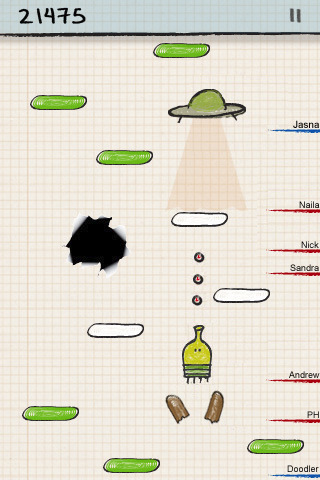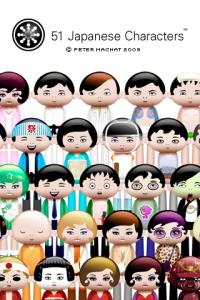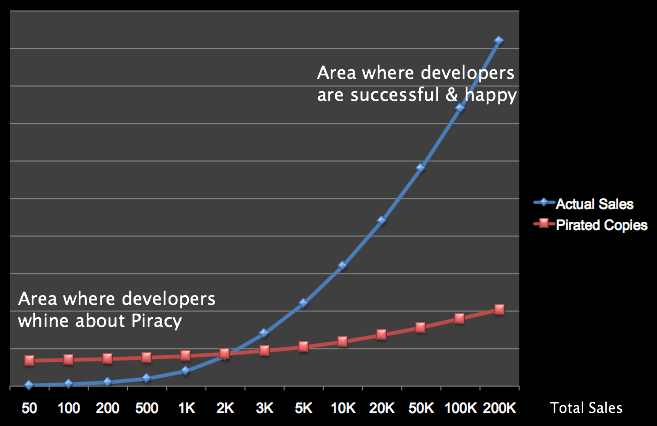If you think your game suffers tremendeously from App Store Piracy, you’re wrong. To put it bluntly: your game has simply failed on the market!
Reports that put the App Store piracy rates at “at least 60%” and developers reporting piracy rates of 80% and even up to 95% are mathematically correct but what they often forget to tell you are actual sales numbers. In the rare cases where Indie developers also mention how many sales they have made, pirates or not, these numbers are always extremely low. For a commercial developer who reports an 80% piracy rate on one of his games it’s simply an attempt to turn terrible sales into a PR story which might give their game a little bit more attention. In fact, i expect the games who report piracy rates of over 30% to have sold no more than 5,000 copies. At $.99 this creates a revenue of $3,500 - maybe a good number for a two-man team but a catastrophe for a commercial developer. This is hardly a problem caused by piracy but a simple failure of the product on the market.
What you have to understand about Software Pirates in general: they use a lot of software. In fact, this is their hobby and favorite passtime, to try out as much software as they can get their hands on. So you will always have a minimum amount of pirated copies of each piece of software, no matter how successful this software is (or not). Of course, with higher success and more sales of the software more pirates are also likely to use it because they, too, value quality software. But given the amount of jailbroken iPhone devices prepared to run pirated software there’s a hard cap of the maximum amount of piracy you will ever see on any title. Just as much as there will be a minimum number of pirates playing every game as soon as it becomes available and regardless of how successful it is on the App Store. If your sales are close or below that minimum number of pirates, you naturally get piracy rates of over 50%. These pirates don’t cut into your revenue however. Ignore them. They never would have bought your App in the first place!

David Rosen from Wolfire reports in his Another View on Piracy article that the highest number of Jailbroken iPhones worldwide is said to be 10%, and in the USA - whose users constitute about two thirds of the iPhone/iPod market - the number of jailbroken devices is just 5%. Assuming a total installed base of 75 Million iPhones (50 Mio. as of April 2010) and iPod touches (20 Mio. as of Sept. 2009) we get at most 7.5 Mio jailbroken devices worldwide, or approximately 2.5 Mio jailbroken devices in the USA. They are not all pirates, however. PinchMedia reports that 38% of jailbroken devices have run at least one pirated App. They also state this number is low. So let’s just take half and we’ll end up with 3.75 Mio. jailbroken devices worldwide which have run at least one pirated App. Still a pretty high number - but it only tells us that they have started one pirated App but not how many or how much of a pirate these users really are. If i had to guess i would say that 10% or just about 400,000 of these users are active pirates who try out a lot of Apps on an almost daily basis. These are the pirates who make the biggest impact in terms of per-App piracy numbers. They are also the users who are least likely to upgrade their pirated copy to a legal one, if they ever do it at all. And trying to fight these pirates is anything but futile - they will never be your customers!
PinchMedia also supports my theory that most Pirates try out as much Software as they can which, of course, leaves less time to use each App intensely: “Pirated applications are used less frequently, less intensely, and for a shorter overall length of time than purchased applications.”
Let’s go back to the gist of it: developers who have a problem with App Store Piracy have, in my opinion, either a problem of perception or they’re making a simple PR statement aimed at getting them more attention, hoping to achieve better sales. The developers who suffer most from App Store Piracy are those who simply are not successful. Their real problem isn’t Piracy, it’s much more likely that they failed either at Marketing, Timing, Quality or finding their Target Audience.
Let me sum this up with a simple chart which i think explains why App Store developers report amazingly high piracy rates, when in fact they are reporting the commercial failure of their App:
Check out my profile on TheyMakeApps. It’s a cool site to get listed on if you do iPhone or Mobile Development in general.
They have a free account and a commercial which costs a whopping $89 per month. Given how frequented the site is i think for some developers it can be worth it but most should be ok with the free account. Once you have customers you should try to make them feel happy and foster that connection - if it is a good one. It’s much easier to close a deal with someone you know and worked with rather than finding another contractor. But to make the first connections a place like TheyMakeApps can be pure gold!
Before you create your own profile, take a look at the existing ones and check which you find the most impressive. Make sure you sell yourself well. A one-liner “I’m a programmer, i can make iPhone Apps.” just won’t cut it. Remember, you’re selling yourself, so put on that Marketing hat before you write.
This one should be obvious: making games is hard.
What’s not so obvious: making simple games is still hard.
Ever heard someone proclaim “Oh, i could make that in a day!” after having glanced at yet another simple game that’s all the rave on the App Store? I bet you did. Truth is: they’re almost always wrong. Even if it’s someone who has years of experience programming games.
You know Jamie from Mythbusters is saying in their disclaimer shots: “It may not look like it, but we’re professionals”. Well, the Mythbusters are professionals. Who is to say you can’t fool around like a child and still be professional? It’s much like your regular game development team. Anyway, did you ever notice how surprised they often are about their results? Or how much work it would be to get their myths tested? Same goes for game developers.
A game programmer who is sure he can do that game in a day just by looking at it is a lot like your typical Mythbuster, or Mythbuster viewer, who thinks they know the outcome before the test - and then they’re in for a surprise. Sure sometimes they’ll be largely correct. Yes you can shoot a ball at 60 mph in the opposite direction of a car going 60 mph and the ball will just drop down straight to the ground. That is just simple physics. Even i knew that. I also know how to make games. And i can vividly imagine how many more tests and excrutiating amounts of work went into confirming that myth. The same amount of excrutiating work and detailed adjustment go into making any game as well. But they don’t show that on your screen, do they?
Game programmers who can actually make a complete game in a day are a myth. Once you’ve done a couple games you know that. And once you hear someone proclaim they can do it in a day, please take them by their word and put them to the test!
Let’s take Doodle Jump as an example. It’s been a target for ridicule from quite some game programmers who just couldn’t stand that something as simple (and stupid as they say) can be so successful. Could you do it in a day? Could you even do it in a week? Let’s put it to the test!
How?
Simple, we’ll just make a feature list and you can answer the question yourself: how long will it take to complete this? Please post in a comment how long you think it would take to complete all this, assuming you had all the graphics and sounds.

- Menu
- Challenge by Email
- Highscores Screen: Local, Facebook Friends and Global (Webserver connection)
- Options Screen, various options
- Connect & Submit Score to Facebook (Facebook API)
- Connect & Submit Score to Twitter (Twitter API)
- Change your name
- Pause Screen
- Game
- Player jumping
- Accelerometer controls
- Wrap Player when leaving either screen side
- Player shooting on tap
- Scrolling Game Objects as Player goes up
- Scroll in Menu on game over
- 7 different Platform Types, one that can be moved by touching it
- 6 Enemies and 1 or 2 Boss Monsters
- UFOs and Black Holes
- 6 Powerups: Springs, Jetpack, etc.
- Display Friend Scores on the side
- Score display
- Stuff that people often forget to think of
- randomly generate platforms in a meaningful way with progressing difficulty and no unfair situations
- cheats and easter eggs (not mandatory but Doodle Jump has a lot!)
- several themes with all new graphics
Did i forget anything? Probably. Usually when you make feature lists like this you get 80%, maybe 90% of all features of you’re really thorough. There’s always something you’ll forget when you look at a game’s features, and there’s even more you’ll forget when you plan the game. Unless you plan for “When it’s done.” - which more often than not means: never. Or Duke Nukem Forever. Same thing really.
I stumbled across this AppBoy Blog Post about Android and its Market. And it reminded me of what i think when i hear people swearing by the Android: the Android is not going to rule the world. Period.
The reasons are not many but they are crucial. First, Open Source is not a Feature! I hear that very often. “Yeah but Android is Open Source, you can’t compete with that!”. Uh-huh. As a matter of fact, i do not want to compete with Open Source if that means low-quality crap. There is no quality control on the Android Market. For some this spells freedom of choice and what not. And yes, Apple has made some decisions to pull apps from the App Store that a lot of people didn’t like. But let’s not forget that 99% of iPhone OS users just don’t care. There’s still enough diversity, and it’s not like Apple has pulled the Facebook App, Twitterific, Doodle Jump or Angry Birds. Apps that people really use and like. Keep in mind that whenever Apple decides to pull an App, recently that was because of mature content while allowing a big player in that market to keep his Apps online, people talk about that because (a) they like to get upset and (b) the blogosphere and news outlets need something to talk about. In the end it’s just hot air.
Let’s get back to Android though. So it’s open source. What does that even mean? The OS itself is open source. Great for the companies who build their own devices on that software. Bad for the consumer: you still have the same problem all mobile phones have. It’s like switching from Nokia and it’s hundreds of different devices united by the Ovi Store to Android, with its hundred and more and more diverging devices and a united App Store. Where does that lead us? A huge pile of free choice no one really wants if you so will. For developers it gets increasingly harder to develop Apps that run on all Android devices and what’s more, even if you manage to support 99% of all devices right now, tomorrow there will be a new device coming out that won’t run your app. As an independent developer this is hell. You have no way of telling whether supporting a specific line of Android devices will get you a significant sales boost. So how do you calculate how much time you’ll spend on each? It’s pure guesswork. I pity Android developers.
The iPhone market itself is hard but there’s one thing you can and should put all your efforts in: Marketing. You develop for one device (well, ok make that 3) while in the meantime you figure out which websites to target, what to blog, which communities to join, where to apply for App reviews, what Press Releases to send out, etc. The code is already done, Marketing your App is the hard part. It’s the same with the Android, except that the code part with its diverging devices is just as hard to do. And it’s just not fun adapting the same app to different devices. It’s one of the things i wouldn’t mind not doing.
Most of the outspoken people who choose Android choose it because they don’t like Apple (fair enough), or they don’t like closed ecosystems and enjoy (really?) everything that has the label “Open Source” attached to it. However, they’re a minority on the Android market. Most Android users just got what they needed: a working mobile phone. They have no idea, and no clue and don’t care about Open Source. For them, the label “Open Source” has no meaning.
I’m sure you’ll want to know which iPhone games i’ve worked on. I’ll keep updating this post. Latest releases are on top.
Undisclosed Project
More info soon …
Black Hole
Created for Fun Armada, our iPhone game company startup. Published by ClickGamer.
 |
 |
MIX-MAX iPad Edition
Contract work for Ravensburger Digital
 |
 |
MIX-MAX
Contract work for Ravensburger Digital
 |
51 Japanese Characters
Pro Bono project for Peter Machat.
 |
 |
Steffens Complete Gameography
You can view my complete Gameography which includes the PC and Handheld titles i’ve worked on at my professional job application website www.gametooldeveloper.com.













